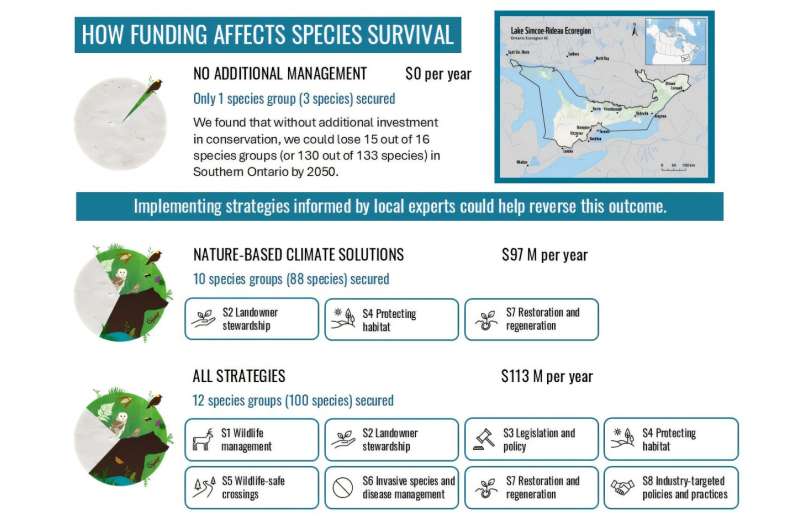A new study reveals that **130 species** in **Southern Ontario** are at risk of local extinction by **2050** unless urgent actions are taken. Conducted by researchers from the **University of British Columbia** and the **World Wildlife Fund Canada**, the study highlights the pressing need for conservation efforts to prevent the decline of these species, 98% of which face significant threats without intervention.
The research, published in the journal *Ecological Solutions and Evidence*, points out that an investment of just **$7** per Ontarian could significantly benefit **75%** of these vulnerable species, including the **black bear**, the **short-eared owl**, and the **Blanding’s turtle**. The Lake Simcoe-Rideau ecoregion, identified as a critical area for biodiversity, is home to **133 species** that are currently at risk.
Abbey Camaclang, a study author and researcher at UBC’s faculty of forestry, stated, “If Ontario continues with a ‘business as usual’ approach, **130 species—98%** of those at risk—could disappear from the region by **2050**.” The findings underscore the importance of proactive measures to enhance biodiversity.
Investment in Conservation Strategies
The study indicates that an annual investment of **$113 million** in eight conservation strategies could facilitate the recovery of **100 species**. This figure represents less than one-tenth of one percent of Ontario’s projected **2024 provincial budget**. The identified strategies encompass habitat protection, wildlife management, invasive species control, and the establishment of wildlife-safe crossings.
Researchers employed the **Priority Threat Management (PTM)** framework, developed by **Dr. Tara Martin** and her team, to analyze the most effective conservation actions. PTM leverages local expertise to assess costs, benefits, and feasibility, aiming to maximize biodiversity gains at minimal expense.
Dr. Martin emphasized the urgency of the situation, remarking, “In Canada, we have **864 species** at risk of extinction and no costed plan to save them.” The application of PTM not only identifies the necessary funding but also outlines how to optimize existing resources for conservation efforts.
Broader Benefits of Conservation
Beyond the immediate benefits for wildlife, the strategies proposed through PTM could enhance water quality, protect culturally significant species for Indigenous Peoples, and contribute to job creation. Conserving and restoring habitats in the region could potentially reduce greenhouse gas emissions by at least **11.2 million tonnes CO2 equivalent** while sequestering **137.6 million tonnes CO2 equivalent**. This dual impact positions conservation as a crucial element in mitigating climate change.
James Snider, Vice President of Science, Knowledge, and Innovation at WWF-Canada, remarked on the broader implications of the findings. “PTM highlights the urgent need for action in Ontario, especially as environmental protections like the **Endangered Species Act** are under threat,” he noted. He warned of the potential loss of species such as the **American bumble bee**, **barn owl**, **Eastern wolf**, and **piping plover**, which would have detrimental effects on ecosystems and community well-being.
The **University of British Columbia** and WWF-Canada have already implemented the PTM framework in the **Wolastoq watershed** in New Brunswick, demonstrating the effectiveness of the approach. Through collaborations with local partners, they have successfully restored over **5,300 hectares** of habitat and planted more than **31,000 trees and plants**.
By applying PTM to the Lake Simcoe-Rideau ecoregion, researchers aim to provide decision-makers with a clear roadmap for recovering species at risk while delivering substantial environmental and societal benefits. The study calls for immediate action to protect biodiversity in Southern Ontario, emphasizing that the future of these species depends on proactive conservation efforts.







